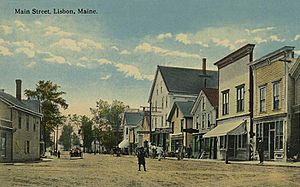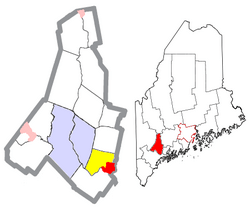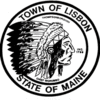Lisbon, Maine facts for kids
Quick facts for kids
Lisbon, Maine
|
||
|---|---|---|

Main Street c. 1914
|
||
|
||

Location of the town of Lisbon (in yellow) in Androscoggin County and the state of Maine
|
||
| Country | United States | |
| State | Maine | |
| County | Androscoggin | |
| Incorporated | June 22, 1799 | |
| Villages | Lisbon Lisbon Center Lisbon Falls |
|
| Area | ||
| • Total | 23.82 sq mi (61.69 km2) | |
| • Land | 22.82 sq mi (59.10 km2) | |
| • Water | 1.00 sq mi (2.59 km2) | |
| Elevation | 200 ft (61 m) | |
| Population
(2020)
|
||
| • Total | 9,711 | |
| • Density | 426/sq mi (164.3/km2) | |
| Time zone | UTC−5 (Eastern (EST)) | |
| • Summer (DST) | UTC−4 (EDT) | |
| ZIP Codes |
04250 (Lisbon)
04252 (Lisbon Falls) |
|
| Area code(s) | 207 | |
| FIPS code | 23-40035 | |
| GNIS feature ID | 0582563 | |
Lisbon is a town located in Androscoggin County, Maine, in the United States. In 2020, about 9,711 people lived there. Lisbon is part of the larger Lewiston-Auburn area in Maine.
The town of Lisbon includes two main villages: Lisbon and Lisbon Falls.
Contents
History of Lisbon
Lisbon was once part of a bigger area called Bowdoin. It was hard for people to travel to town meetings. So, on June 22, 1799, the government of Massachusetts divided Bowdoin into two parts. The new part was named Thompsonborough.
Changing the Town's Name
People living in Thompsonborough didn't like the long name. In 1802, they decided to rename it Lisbon. The new name came from Lisbon, a famous city in Portugal.
In 1808, Lisbon grew bigger by adding a nearby area called Little River Plantation. This area became what is now known as Lisbon Falls. Later, in 1840, a part of Lisbon was separated to form the town of Webster.
Early Industries and Mills
The land in Lisbon was very good for farming, so this was one of the first main jobs. People also built sawmills and gristmills. These mills used the power of flowing water from streams to operate.
Later, bigger brick mills were built to make textiles, which are fabrics like cloth. In 1864, a large mill called the Worumbo Mill opened. It made woolen fabrics and was a major employer in the town for many years. The mill sadly burned down in 1987.
Geography and Rivers
The town of Lisbon covers about 23.82 square miles (61.69 square kilometers). Most of this area is land, about 22.82 square miles (59.10 square kilometers). The rest is water, about 1.00 square mile (2.59 square kilometers).
Several rivers flow through Lisbon. These include the Sabattus River, the Little River, and the important Androscoggin River. These rivers have played a big role in the town's history and development.
Population and People
| Historical population | |||
|---|---|---|---|
| Census | Pop. | %± | |
| 1810 | 1,614 | — | |
| 1820 | 2,240 | 38.8% | |
| 1830 | 2,423 | 8.2% | |
| 1840 | 1,532 | −36.8% | |
| 1850 | 1,495 | −2.4% | |
| 1860 | 1,376 | −8.0% | |
| 1870 | 2,014 | 46.4% | |
| 1880 | 2,641 | 31.1% | |
| 1890 | 3,120 | 18.1% | |
| 1900 | 3,603 | 15.5% | |
| 1910 | 4,116 | 14.2% | |
| 1920 | 4,091 | −0.6% | |
| 1930 | 4,002 | −2.2% | |
| 1940 | 4,123 | 3.0% | |
| 1950 | 4,318 | 4.7% | |
| 1960 | 5,042 | 16.8% | |
| 1970 | 6,544 | 29.8% | |
| 1980 | 8,769 | 34.0% | |
| 1990 | 9,457 | 7.8% | |
| 2000 | 9,077 | −4.0% | |
| 2010 | 9,009 | −0.7% | |
| 2020 | 9,711 | 7.8% | |
| U.S. Decennial Census | |||
Lisbon's Population in 2010
In 2010, there were 9,009 people living in Lisbon. These people lived in 3,696 households. A household is a group of people living together in one home.
Most people in Lisbon were White (96.2%). A small number of people were African American (0.6%), Native American (0.5%), or Asian (0.5%). About 1.0% of the population identified as Hispanic or Latino.
Many households (32.4%) had children under 18 living with them. About half of the households (49.4%) were married couples living together. The average age of people in Lisbon was about 39.4 years old.
Education in Lisbon
The Lisbon School Department manages the schools in town. There are three main schools for students of different ages:
- Lisbon Community School
- Philip W. Sugg Middle School
- Lisbon High School
The Superintendent of Schools is Rick Green, who helps lead the school system.
Notable People from Lisbon
Many interesting people have connections to Lisbon. Here are a few:
- Dale J. Crafts: A state legislator, meaning he helped make laws for the state.
- William Dunn: A sailor who was recognized for his bravery.
- Benjamin Franklin Dunning: Known as a builder.
- Howard Gerrish: An author and teacher.
- John Gould: A writer who wrote columns for newspapers.
- Louis A. Jack: A state legislator and a leader in Maine's trade board.
- Stephen King: A very famous writer of many books.
- Garrett Mason: Another state legislator.
- Gina Mason: Also a state legislator.
- Greg Moore: A professional ice hockey player.
- James Tierney: A politician.
See also
 In Spanish: Lisbon (Maine) para niños
In Spanish: Lisbon (Maine) para niños




